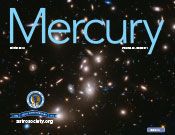Winter 2014 - Volume 43, Number 1

Table of Contents
[17] Celebrating the ASP’s Past Quarter Century, Andrew Fraknoi
A long-time ASP staff member (and former Executive Director) recalls some of the Society’s activities during the past 25 years.
[28] Discovering the Universe at Astronomy Camp, Elena Saavedra Buckley
Research and fun go hand-in-hand during Kitt Peak’s nine-day Advanced Teen Summer Astronomy Camp.
[35] Astronomy in the News
Water vapor venting from Europa, a planet around a solar twin in a star cluster, and Hubble’s new perspective on the remote universe — these are some of the discoveries that recently made news in the astronomical community.
Departments
[4] Perspectives, Paul Deans
The Sky Aflame
[5] First Word, Jim Manning
Milestones
[7] Annals of Astronomy, Clifford J. Cunningham
Comets a Century Ago
[8] Astronomer’s Notebook, Jennifer Birriel
A New Cosmological Tool
[10] Planetary Perspectives, Emily Joseph
Seasons Greetings
[12] Armchair Astrophysics, Christopher Wanjek
A Simple Test for String Theory?
[13] Education Matters, David Bruning
Grail Quest
[15] Reaching Out, Bethany Cobb
Turnover
[44] ASP Tidings/Thanks to ASP Supporters
[48] Sky Sights, Paul Deans
April’s Lunar Eclipse
[51] Reflections, Jet Propulsion Laboratory
A Different Look at Saturn
Celebrating the ASP’s Past Quarter Century
by Andrew Fraknoi
In 1989, the Astronomical Society of the Pacific (ASP) celebrated its 100th year of service to astronomy, education, and the public. Now, remarkably, another 25 years have passed, and the ASP commemorates its 125th anniversary on February 7, 2014. As the Executive Director of the Society from 1978 to 1992, and then as Senior Educator, I was deeply involved in the ASP’s past quarter century.
Obviously it’s not possible to do justice, in this short article, to the full range of the Society’s activities during the past 25 years. So my aim is to highlight the ones that I have some personal knowledge of and that may be of interest to our readers.
Discovering the Universe at Astronomy Camp
by Elena Saavedra Buckley
There’s a saying I’ve heard in multiple forms, but the basic premise is this. No matter where you are, you can look up at the Moon and know that someone, somewhere else in the world, is looking up at the same one.
If you happened to gaze at the Moon in late June during the past few years, chances are a group of teenagers was looking at it too. These teens, though, were probably looking at it a bit differently — with giant telescopes on a high peak in Arizona.
They were attending Astronomy Camp, a nine-day summer program held at Kitt Peak National Observatory near Tucson, Arizona. I had the privilege of being one of those teenagers this past year at the Advanced Teen camp, and I know I’ll never look at the Moon, or the rest of the sky, in the same way.
First Planet Found Around Solar Twin in Star Cluster
European Southern Observatory
Astronomers have used ESO’s HARPS planet hunter in Chile, along with other telescopes around the world, to discover three planets orbiting stars in the cluster Messier 67. Although more than one thousand planets outside the solar system are now confirmed, only a handful have been found in star clusters. Remarkably one of these new exoplanets is orbiting a star that is a rare solar twin — a star that is almost identical to the Sun in all respects.
Anna Brucalassi (Max Planck Institute for Extraterrestrial Physics, Garching, Germany), lead author of the new study, and her team wanted to find out more. “In the Messier 67 star cluster, the stars are all about the same age and composition as the Sun. This makes it a perfect laboratory to study how many planets form in such a crowded environment, and whether they form mostly around more massive or less massive stars.”
The team carefully monitored 88 selected stars in Messier 67 during a period of six years to look for the tiny telltale motions of the stars towards and away from Earth that reveal the presence of orbiting planets.
Three planets were discovered, two orbiting stars similar to the Sun and one orbiting a more massive and evolved red giant star. The first two planets both have about one-third the mass of Jupiter and orbit their host stars in seven and five days respectively. The third planet takes 122 days to orbit its host and is more massive than Jupiter.
The first of these planets proved to be orbiting a remarkable star — it is one of the most similar solar twins identified so far and is almost identical to the Sun. It is the first solar twin in a cluster that has been found to have a planet. Two of the three planets are “hot Jupiters” — planets comparable to Jupiter in size, but much closer to their parent stars and hence much hotter.
Accessing Mercury Magazine
Published since 1972, Mercury Magazine is now published four times a year for ASP Members and Institutional Subscribers. The Mercury Archives offer a table of contents for each of the digital issues going back to 2007. Members and Subscribers have access to the complete digital library of the full magazines.
ASP Members simply Log In to access all full digital issues through the MyASP Portal.
Not an ASP Member? Join today to enjoy a full year subscription, an archive of digital issues since 2007, as well as other benefits.
Institutional Subscribers must access the full library of digital issues through your Institution.
Mercury now has a voice beyond its Members as we launch Mercury Online, featuring our recognized columnists, current space news, and more in a new and up-to-date blog format.
"We live in turbulent yet exciting times, so it is our hope that Mercury Online will showcase humanity's drive to explore by delivering high-quality articles for members and nonmembers alike." — Ian O'Neill, Editor, Mercury magazine and Mercury Online
